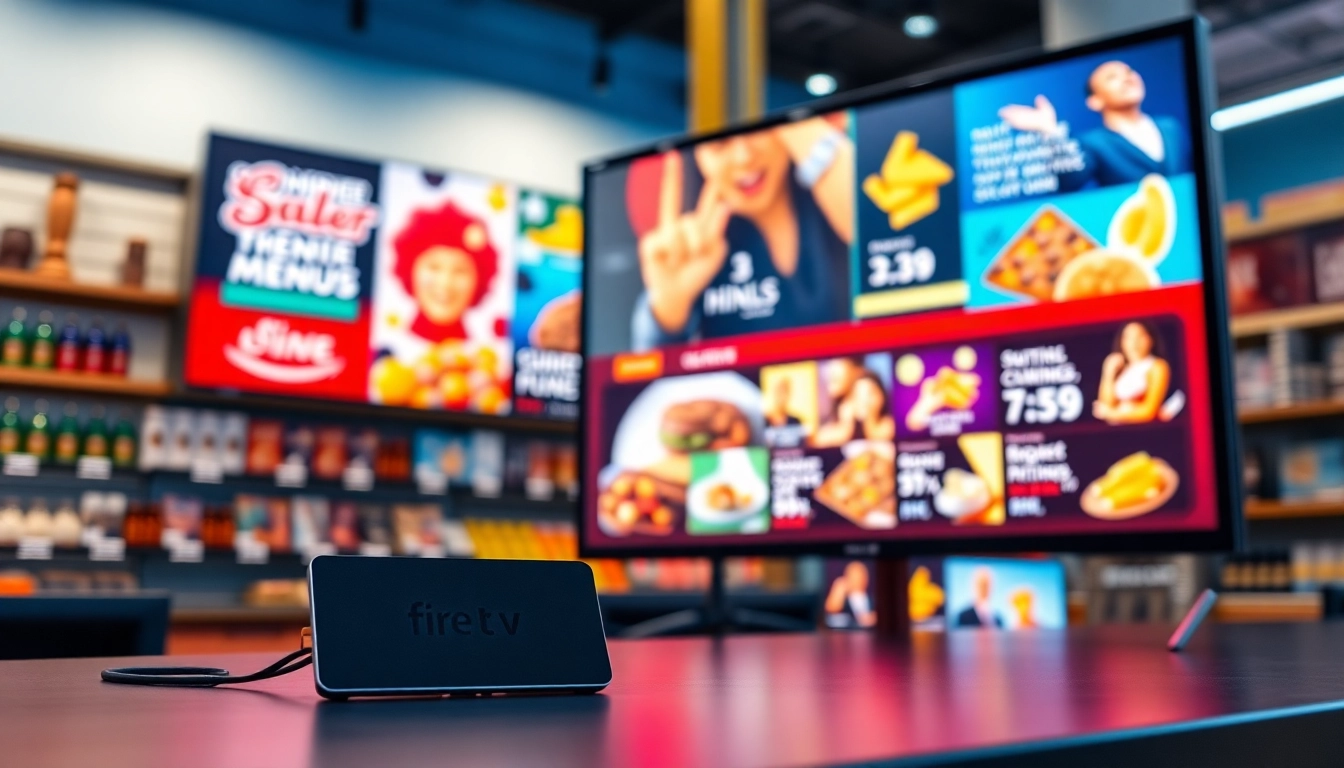
Introduction to Fire TV Digital Signage App
As businesses and organizations strive to captivate and engage their audiences, digital signage has emerged as a powerful tool for communication. The Fire TV digital signage app plays a crucial role in this ecosystem, enabling users to turn any compatible television into an effective marketing and information display. This article provides an extensive overview of digital signage, its benefits, the role of Fire TV in this space, and practical insights on utilizing the Fire TV digital signage app effectively.
Understanding Digital Signage and Its Benefits
Digital signage refers to the use of digital displays—such as LCD, LED, or projection displays—to convey information, advertisements, or other content. Unlike traditional print signage, digital signage allows for dynamic and flexible content management. Here are some key benefits of digital signage:
- Real-time Updates: Businesses can update their content instantly, ensuring that information is always current.
- Increased Engagement: Eye-catching graphics and videos capture the audience’s attention more effectively than static signs.
- Cost-Effective: Over time, digital signage can reduce printing and labor costs associated with traditional signage.
- Customizable Content: Users can tailor messages to specific audiences or locations, improving relevance and impact.
- Analytics and Insights: Digital signage solutions often come with analytics capabilities, allowing businesses to track viewer engagement and effectiveness.
How Fire TV Fits into the Digital Signage Landscape
As a widely used streaming device, Amazon’s Fire TV provides a unique platform for digital signage applications. Its ease of use, affordability, and extensive compatibility offer businesses an accessible entry point into digital signage. With the proliferation of Fire TV devices, leveraging them for digital signage can help streamline content delivery and enhance audience engagement.
Key Features of the Fire TV Digital Signage App
The Fire TV digital signage app comes equipped with several features designed to enhance user experience and content management:
- User-Friendly Interface: The app typically offers an intuitive interface that allows users of all skill levels to navigate and manage their content effortlessly.
- Multiple Content Formats: Users can display various content types, including images, videos, social media feeds, and live data.
- Remote Management: The ability to manage displays remotely ensures that users can update content from anywhere, making it convenient for multi-location businesses.
- Scheduling Capabilities: Users can schedule content to display at certain times, optimizing the relevance and timing of promotions.
- Analytics and Performance Tracking: Many apps offer tools to analyze viewer engagement, helping businesses optimize their display strategies based on real data.
Setting Up Your Fire TV Digital Signage App
Initial Setup Steps for Fire TV
Setting up the Fire TV for digital signage involves several straightforward steps that ensure the device is optimized for displaying content effectively:
- Connect the Fire TV: Plug the Fire TV into the HDMI port of your television and connect it to a power source.
- Set Up Your Account: Follow the on-screen instructions to connect to Wi-Fi and sign in with your Amazon account. If you do not have an account, you will need to create one.
- Download the Digital Signage App: Navigate to the Amazon Appstore from your Fire TV home screen and search for your chosen digital signage app.
Installing the Digital Signage App
Installing the app is a crucial step in your Fire TV setup process. Here’s how to do it:
- Search for the App: Using the search feature, enter the name of the digital signage app you want to install.
- Select and Download: Click on the app icon and select ‘Download’ to begin the installation process.
- Open the App: Once installed, open the app from your Fire TV homepage to start setting up your displays.
Configuration Options for Content Management
After installation, you may need to configure the app to suit your content management needs:
- Create an Account: Most digital signage apps require you to create an account to manage content and access features.
- Set Display Preferences: Adjust settings according to your display requirements—resolution, orientation (portrait or landscape), and screen brightness.
- Add Content: Upload images, videos, and other forms of content that you plan to display.
- Organize Content: Use playlists or categories within the app to organize your content effectively for easy access and scheduling.
Creating Compelling Content with Fire TV Digital Signage App
Designing Engaging Visuals for Your Audience
Once your Fire TV digital signage app is set up, creating visually appealing content is essential to capturing and retaining viewer attention. Here are some tips on designing engaging visuals:
- Use High-Quality Images: Ensure that all images are high resolution to avoid pixelation on larger screens.
- Incorporate Brand Elements: Use consistent branding—colors, logos, and fonts—to reinforce your brand identity.
- Keep It Simple: Avoid cluttered designs; focus on clear visuals and concise messaging.
- Utilize Motion: Animated content tends to draw attention more effectively than static images.
- Test on Different Screens: Always test how your content looks on various display sizes and resolutions to ensure compatibility.
Best Practices for Content Scheduling
Content scheduling is a powerful feature in digital signage that allows businesses to display different content at specific times. To make the most of this feature, consider the following best practices:
- Audience Timing: Schedule content according to when your target audience is most likely to engage with it—such as lunchtime specials in a café or announcements during business hours for corporate environments.
- Seasonal Campaigns: Modify your content to reflect holidays, events, or seasonal changes in your business environment.
- Regular Updates: Refresh your content regularly to prevent viewer fatigue and keep the messaging resonant.
- Utilize Analytics: Monitor performance metrics to refine your scheduling strategy based on what times yield the best engagement.
Types of Content to Display Effectively
Displaying varied and relevant content is key to maintaining viewer interest. Here’s a look at effective content types for use with the Fire TV digital signage app:
- Promotional Videos: Showcase products, services, or upcoming events through engaging video clips.
- Customer Testimonials: Highlight customer reviews or video testimonials to build trust.
- Real-time Updates: Display live feeds from social media, weather updates, or news to keep your content fresh and engaging.
- Interactive Content: Incorporate interactive polls or surveys to encourage viewer participation.
- Events Calendar: Share information about upcoming events, special promotions, or changes to regular business hours.
Monitoring and Managing Your Signage Displays
Tracking Viewer Engagement and Performance Metrics
Continuous monitoring of your digital signage displays is essential to understanding how well your content is performing. Utilize built-in analytics tools to track metrics such as:
- View Duration: Measure how long viewers are engaged with your content.
- Content Interactions: Track which content types are getting the most interactions, allowing for smarter content strategy adjustments.
- Audience Demographics: Understanding the demographics of your audience can help tailor messaging effectively.
- Conversion Metrics: For businesses focused on sales, track how many viewers take desired actions after seeing specific content (e.g., visiting a website, making a purchase).
Remote Management Capabilities
The ability to manage your digital signage remotely adds a layer of convenience that can boost efficiency and responsiveness. Here’s how remote management can benefit users:
- Update Content Remotely: Change what’s displayed without needing to physically access the device, which is especially beneficial for multi-location businesses.
- Live Monitoring: Check that displays are functioning correctly from different locations, ensuring that all content is being shown as intended.
- Instant Notifications: Receive alerts about any issues that may arise with your displays, allowing for timely resolutions.
- Data Insights Access: View analytics and performance data from anywhere, helping to drive informed decision-making.
Updating Content on the Go
Being able to update content quickly and efficiently is vital for effective digital signage. Here are a few strategies to facilitate this process:
- Use Cloud Storage: Store content in the cloud to enable easy access and modification, removing the dependency on local storage devices.
- Set Up Automatic Updates: Schedule automatic content updates during off-peak times to ensure changes occur seamlessly without disrupting viewer experience.
- Leverage Mobile Apps: Use mobile management apps that allow for quick updates on the go, providing flexibility when you’re away from your primary workspace.
- Implement Version Control: Keep track of different content versions, making it easy to revert to previous iterations if needed.
Advanced Tips for Enhancing Your Fire TV Digital Signage Experience
Integrating Interactive Elements into Your Displays
Incorporating interactive elements into your digital signage can significantly enhance audience engagement. Consider these strategies:
- Touchscreen Functionality: If possible, integrate touchscreen capabilities that allow viewers to interact directly with the content.
- QR Codes: Include QR codes that link to additional information, promotions, or websites, bridging physical and digital interactions.
- Audience Polls: Use the signage to solicit feedback through polls or quizzes, engaging viewers and gathering valuable data.
- Social Media Integrations: Display live social media feeds where viewers can see their interactions in real time.
Leveraging Analytics for Improved Strategies
Analytics should play a central role in shaping your digital signage strategy. Here’s how you can leverage data for improvements:
- Identify Content Performance: Regularly analyze which pieces of content perform best and adapt your strategy based on that data.
- A/B Testing: Experiment with different versions of messages and layouts to see which resonates more effectively with your audience.
- Audience Insights: Use demographic data to target specific segments within your audience, tailoring content to meet different preferences.
- Temporal Analysis: Analyze engagement by time of day or week to optimize your content schedule for peak viewing times.
Future Trends in Digital Signage on Fire TV
As technology continues to evolve, digital signage will also see exciting advancements. Here are some trends to expect in the future:
- AI-Powered Personalization: Artificial intelligence will enable more personalized content based on viewer behavior and preferences, creating targeted experiences.
- Increased Integration with IoT: The Internet of Things will allow digital signage to communicate more seamlessly with other devices and systems.
- Augmented Reality Experiences: AR will enable dynamic interactions where digital signage can interact with the physical environment, enhancing viewer engagement.
- Sustainability Initiatives: As businesses become more environmentally conscious, digital signage will trend towards more sustainable practices, such as energy-efficient displays and eco-friendly materials.







